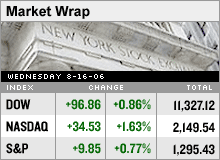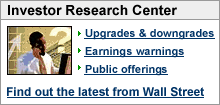|
Stocks rally, day two Major gauges extend previous session's advance on bets that lower inflation means Fed can keep rates steady; falling oil prices help. NEW YORK (CNNMoney.com) -- Stocks surged Wednesday, rallying for the second straight session on bets that the day's benign inflation news is further evidence that the Federal Reserve can keep interest rates steady. The Nasdaq composite (up 34.53 to 2,149.54, Charts) gained around 1.6 percent. The tech-fueled composite has now gained nearly 4 percent in two days.
The Dow Jones industrial average (up 96.86 to 11,327.12, Charts) added nearly 0.9 percent, and the broader Standard & Poor's 500 (up 9.85 to 1,295.43, Charts) index added around 0.8 percent. Treasury prices rallied for the second session, lowering the corresponding yields. The dollar tumbled for a second session. Oil prices slipped, and gold prices rose. After the close, Hewlett-Packard (Charts) reported quarterly earnings and revenue that rose from a year ago and topped forecasts. The stock rose at least 4.5 percent in extended-hours trading. Thursday brings reports on leading economic indicators and the Philadelphia Fed, a regional read on manufacturing. Stocks have rallied for two days straight now after Tuesday's report on wholesale prices and Wednesday's read on consumer prices showed less inflationary pressure than had been expected. That added to bets that the Federal Reserve will not have to restart its recently paused interest-rate-hiking campaign next month, soothing investors. "The market is relieved today that the inflation news was not negative," said John Davidson, president and CEO of PartnerRe Asset Management. "It takes the pressure off the Fed for now." However, he cautioned that just because the inflation picture was good for this month doesn't mean it will be good for next month. That's partly because inflation typically continues to increase for six to nine months after the Fed stops raising rates. In addition, Davidson doesn't think the economy has slowed enough yet to help ease inflation, an eventual scenario the Fed pointed to in its decision to pause its rate-hiking campaign. The inflation question All three major gauges surged Tuesday as well, with the Nasdaq scoring its third-best day of the year on a point and percentage basis. The advance followed a report showing that core wholesale inflation had fallen in July, while overall wholesale inflation rose less than expected. That mild report sent stocks higher and bonds lower. Bets on a sustained Fed rate pause intensified Wednesday after the release of the Consumer Price index (CPI). Core CPI rose 0.2 percent in July, the government said Wednesday morning. Economists surveyed by Briefing.com thought it would rise 0.3 percent, as it did in June. Overall CPI rose 0.4 percent in July, in line with estimates, following a rise of 0.2 percent in June. A report on July housing starts and building permits showed the economy continues to moderate. Another report showed that industrial production was weaker in July, while capacity utilization was little changed. Last week, the central bank held a key short-term interest rate steady at 5.25 percent after lifting it 17 times in a row since June 2004. The rationale was that slowing economic growth would brake inflation as well. Yet, market watchers have been skeptical about the likelihood of such an eventuality and have worried that the Fed might have to raise rates again at the next policy meeting Sept. 20. The two days of mild inflation reports seemed to cool these worries. In a broader sense, the advance over the past few days reflects a shift in psychology, said Steven Goldman, market analyst at Weeden & Co. Goldman said that the stock market has had trouble advancing much since March, amid worries that the Fed had gone too far in its rate-hiking campaign and had pushed the economy toward a recession rather than a slowdown. "Now you're seeing a shift in that perception," Goldman said, with investors feeling better in response to last week's Fed meeting and this week's spate of economic reports. However, he said that any stock advance will likely lose steam should the major gauges eventually get closer to the 2006 highs hit in April and May. For the Nasdaq composite, that level is around 220 points away; for the Dow, the level is around 320 points away; for the S&P 500, the level is around 30 points away. What moved? Stock gains were broad based, with 25 out of 30 Dow components rising. Economically sensitive issues such as Boeing (up $2.25 to $78.83, Charts), Caterpillar (up $1.70 to $69.11, Charts) and United Technologies (up $1.41 to $62.17, Charts) all gained more than 2 percent. The Dow's tech components advanced, too, with IBM (up $2.01 to $79.09, Charts) and Intel (up $0.48 to $18.61, Charts) both gaining around 2.6 percent. A number of other widely traded technology stocks advanced as well, including Cisco Systems (up $0.45 to $21.10, Charts), Dell (up $0.65 to $22.73, Charts), JDS Uniphase (up $0.21 to $2.50, Charts), Sun Microsystems (up $0.20 to $4.82, Charts) and Apple Computer (up $1.53 to $67.98, Charts). A number of home-building shares gained, with investors less interested in the weak July housing number and more interested in the sharp drop in interest rates over the past two days, as demonstrated by the Treasury bond market. The Philadelphia Housing (Charts) sector index gained 3.4 percent. Abercrombie & Fitch (up $7.88 to $63.40, Charts) reported quarterly earnings and revenue late Tuesday that rose from a year earlier and beat estimates. The clothing retailer also issued earnings guidance for fiscal 2007 that is higher than analysts' estimates. Shares jumped more than 14 percent in active New York Stock Exchange trading. Applied Materials (up $0.02 to $15.71, Charts) reported quarterly earnings and revenue late Tuesday that rose from a year ago and beat estimates. However, the chip gear maker was more cautious on the current quarter, saying higher chip inventories would hurt demand. Exxon Mobil (down $1.12 to $67.57, Charts) and other oil stocks weakened, along with the price of oil. The Amex Oil (down 10.00 to 1,182.10, Charts) index lost 0.8 percent. Market breadth was positive. On the New York Stock Exchange, winners beat losers almost by more than 3 to 1 as nearly 1.60 billion shares changed hands. On the Nasdaq, advancers topped decliners 2 to 1 on volume of 2.14 billion shares. U.S. light crude for September delivery retreated $1.16 to settle at $71.89 a barrel on the New York Mercantile Exchange after the release of the weekly oil inventories report. The report showed that crude supplies declined about what had been expected after BP shut down half of its Alaska oil field last week. Treasury prices jumped, lowering the yield on the 10-year note to 4.86 percent from 4.93 percent late Monday. Treasury prices and yields move in opposite directions. The dollar slipped versus the euro and yen, falling for the second straight session. Gold prices gained $5.80 to settle at $638.70 an ounce. |
|






